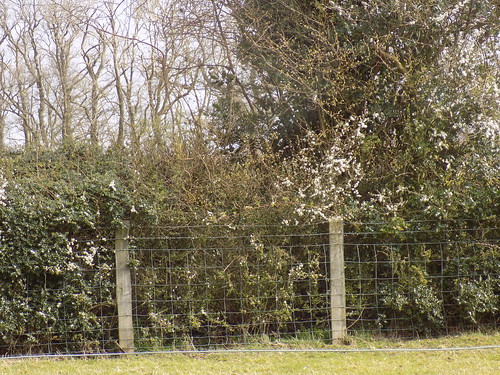As I write this, I am sipping a warming hot chocolate and I have both woodburners lit. Outside, there is a heavy shower of hail and sleet covering the ground with little balls of freezing white stuff. Last night, I brought in the sweet peas that are hardening off before being planted out as I thought the cold may be too much for them. I covered the young parsnips planted out in their bed at the weekend but they are now looking a little sulky following the overnight frost. The Brussels Sprouts spent the night outside unprotected with no adverse effect as they are already quite vigorous and hardy. I have been lambing at our neighbour's these past few days and it has been bitterly cold out in the fields, especially first thing in the morning and in the early evening, when it seems lambs like to be born. Snow is forecast for later today and over the next couple of days! The scene I am describing is rather wintry; yet, we are a few days off Bealtaine, the start of the Celtic Summer!
There is an old saying “Beware the Blackthorn Winter” that warns of a spell of harsh weather when the blackthorn blossom is out. Our hedges are indeed blooming with the very pretty, white flowers on the black, bare but thorny stems of the blackthorn bush at the moment. So the saying, in relation to gardening, teaches us to be aware of and prepare for bad weather at a time when the warm and sunny spells of Spring may lure us into a sense of false security during the planting season. “Beware the Blackthorn Winter” is an ominous warning that we, gardeners, had better hear to take care of our young seedlings and plants and protect them from deadly frost and cold temperatures at this time of year. A chilling message...
Looking more closely at the blackthorn, I can see why it has earned its symbolism of sudden change, challenge, hardship, strife and life and death together. It has been used to represent the dark side of life that we often prefer to ignore. The blackthorn stems are often described as “deadly”. Having caught myself on its long, sharp thorns on several occasions during the Winter, I have cursed them! In fact, pricks and cuts from its vicious thorns can quickly turn septic so it is wise to be prepared and wear gloves when going anywhere near them! Yet, in stark contrast, when the blackthorn blossom is out, the white flowers on these black stems are very pretty, with delicate petals and exquisite stamens of orangey yellow pollen. They have a delicious taste of almonds and are a welcome source of early nourishment for bees and foragers alike. And come the Autumn, the blackthorn's offering takes the form of purpley blue sloe berries, best picked after the first frost and turned into sloe gin.
I value the wise and rich teachings of nature as a guide in my life and it makes sense then that the blackthorn has become associated with the theme of hardship and challenge followed by fruitful reward. Perhaps we can hold in mind the image of the blackthorn bush when we go through difficult times. We can take in its message that some of our sweetest, most fruitful and happiest times come after we have faced a challenge and embraced it as an opportunity for growth and change. A message of hope and promise to help us push through the doom and gloom of our own "Blackthorn Winters" and arrive at the other end better, sweeter, lighter, freer and ultimately more at ease with ourselves, others and life.
For now, as this cold spell is set to continue for the next few days, with the potential for disastrous compromise to my gardening efforts up to now, I shall continue to take the blankets out to the vegetable patch and bring inside the plants that are not yet hardy enough to be outside (oh, and wrap up warm when going out lambing!!), even if it is nearly May!


